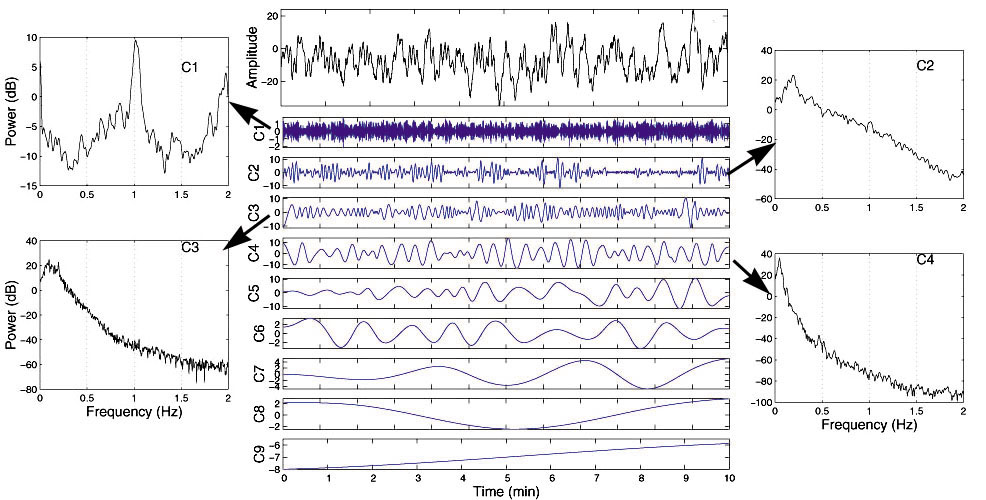
Research Interests
Areas of Interest:
Research Projects:
Computational Methods:

Statistical Analysis of Neural Data
Modern technological advances in multielectrode recordings have produced a deluge of neural data. An exciting challenge is how to make good use of the large amounts of data produced from many simultaneously-recorded neurons. Multivariate AutoRegressive modeling with short, moving analysis windows provides a potential solution. We report on the use of this technique for the analysis of local field potentials to understand how different areas of the cerebral cortex cooperate in large-scale networks during cognitive processing. Relevant publications include:
Short Window Spectral Analysis of Cortical Event-Related Potentials On the Tracking of Dynamic Functional Relations in Monkey Cerebral Cortex
Reorganization of large-scale cortical networks (Red - a dorsal network at 22 Hz involving sites in posterior parietal, somatosensory, and motor areas. Blue - a ventral network at 15 Hz involving sites in striate, prestriate, and inferior temporal areas) in the transition from anticipation to visual stimulus processing (Green - a poststimulus network at 12 Hz).
Causal Influences in the Cortex
The understanding of bottom-up and top-down influences in the visual cortex is of great theoretical importance. Neuroanatomical studies have firmly established the pervasiveness of feedback projections and a number of theoretical formulations have been proposed to explain the functions of these projections. Nontheless, direct neurophysiological observation of feedback (top-down) influences has previously been lacking. We developed a new statistical measure, the short-time directed transfer function (STDTF), to gauge the changing strength and direction of causal influence between cortical sites on a fraction-of-a-second time scale.
Feedforward and feedback DTFs at 12 Hz in monkey GE. The feedforward influence (red) from striate site B to prestriate site C occurs earlier than the feedback influence (blue) from prestriate to striate. The mean and standard deviation at each time point were computed by the bootstrap resampling method.
Information-theoretic techniques are expected to provide complementary information to STDTF. A directional measure, Directed TransInformation, derived from mutual information has been introduced to analyze multichannel neurophysiological data from monkeys. See (Liang et al, Neurocomputing,2001) for additional information.
Independent Component Analysis
Independent Component Analysis (ICA) is emerging as a new standard area of signal processing and data analysis. We have some new thoughts about this topic and apply it to the measurements of gastric electrical activity (electrogastrograms). Relevant publications:
Adaptive Independent Component Analysis of Multichannel Electrogastrograms
Blind Signal Separation with a flexible non-linearity
Adaptive Blind Source Separation through a Maximum Likelihood Approach
Facing the unusual popularity of neural networks in sciences, we attempted to combine genetic algorithm with neural network for automatically determination of the topology of the network for a given problem, and applications in biomedical signal processing and high energy physics experiment. Relevant publications:
Improvement of Cascade Correlation Learning Algorithm with an Evolutionary Initialization
Application of Combined GA with NN to Diagnosis of Delayed Gastric Emptying from Electrogastrograms
Classification of the Primary Cosmic Ray Composition with Neural Networks (High Energy Physics and Nuclear Physics, 21: 3, 205 - 210, 1997)
Evolution of the network with the number of hidden nodes, one by one from 1 to 20, in the two spirals problem.
Support Vector Machine (SVM) is a novel type of learning machine, based on stattistical learning theory, which contains polynomial classifiers, neural networks, and radial basis function networks as special cases. We found it useful for diagnosis of delayed gastric emptying.
Time-Frequency and Wavelet Analysis
Important information often appears through a simultaneous analysis of the signal's time and frequency properties. It is the time-frequency wedding that provides a more general perspective on signal processing. For my Master thesis I introduced the time-frequency analysis for gastric electrical recordings. Recently we show that the wavelet transform in conjunction with fuzzy set theory works great for cancellation of stimulus artifact in the serosal recordings of gastric myoelectric activity. Relevant publications:
Multiresolution Signal Decomposition and its Applications to Electrogastric Signals
Stimulus Artifact Cancellation in Gastric Myoelectrical Recordings Using Wavelet Transform
Nonlinear and Nonstationary Signal Processing
We study
a general applicable method, empirical mode
decomposition, for isolating, identifying and removing a wide variety of
artifacts in the
electrogastrograms. The
technique is ideally suited to nonlinear and nonstationary processes since the
decomposition is based on the local characteristic time scale of the data. This
method, combined with the Hilbert transform, provides not only a more precise
definition of particular events in the time-frequency space than wavelet
analysis, but also more physically meaningful interpretations of the underlying
dynamic processes.

Middle panel: Empirical Mode Decomposition of a typical EGG recording (top) into nine components (C1 to C9) , each with clear physically meaning. Left & right panels: the power spectra of the first four components. The peak frequencies of components C1 to C4 are successively 1.02 Hz, 0.2 Hz, 0.1 Hz and 0.05 Hz, which correspond to the heartbeat, respiratory artifact, harmonic signal and gastric slow wave, respectively.
Last modified: 01/17/2009 11:38:50 AM